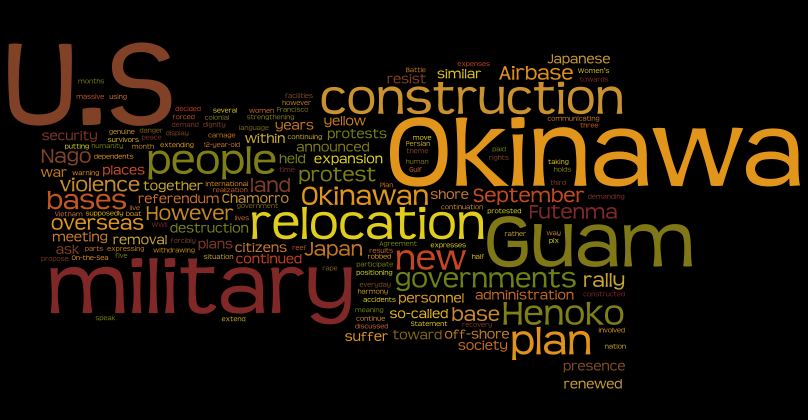

|
|||||||||
|
A wordle of the statement below.
On April 25th, there will be a rally on Okinawa entitled, “The Okinawan people demanding closure and removal of Futenma Airbase, and protest the relocation within Okinawa and demand its relocation to other parts of Japan or overseas”. This rally expresses to the governments of Japan and the U.S. our strong will for the removal of the U.S. Airbase in Futenma. This time, as a new way to present a “yellow card” (of warning to both governments), together with those who cannot participate in the rally, we will wear yellow on ourselves and display it on our cars and homes.
In September 1995, 85,000 Okinawan people came together to protest the rape of a 12-year-old girl (by U.S. military personnel), expressing the Okinawan citizens’ rage towards U.S. military violence which had continued for more than half a century after the end of WWII. In order to subdue this anger, both the U.S. and Japanese governments announced “that [the land used for] Futenma Airbase would be returned within five to seven years.” However, this announcement concealed plans for construction of new U.S. military facilities on the reef off shore of Henoko in Nago, Okinawa. Immediately after the new relocation was announced, a referendum was held in Nago, which resulted in the majority of Nago citizens voting against the new construction. The results of the referendum, however, were ignored. For twelve years after that, protests both “On-the-Sea” and on the beach at Henoko were continued. Finally, on September 2005, both governments decided against the original plan for “off-shore” construction of the base.
However, the following month, in October 2005, a “plan to relocate to Guam” surfaced under the renewed U.S. Japan Realignment Plan. This plan calls for the relocation of 8,000 U.S. marines and 9,000 dependents to Guam by 2014 and for 60% of the expenses to be paid for by the Japanese government. However, this Guam relocation also included plans for new base construction in Okinawa. Under this so-called “Guam relocation Agreement,” base construction would extend from the shore near the Henoko (where off-shore construction had been previously protested). This forced the continuation of protests at Henoko to this day. This plan is just a renewed strengthening and expansion of the U.S. military positioning under the euphemisms “reduction of the burden on Okinawa” and “economic development in Guam.”
We ask the Obama administration if it wants to continue this military plan that it inherited from the former [Bush] administration. We ask the people of the United States to think about what is happening in Okinawa.
In the three months right after the Battle of Okinawa, the U.S. constructed a massive network of military bases in Okinawa while putting Okinawan survivors of the battle into prisoner of war and internment camps and forcibly taking their land. The situation today in Guam is similar as the land of the people of Guam is being robbed for the construction of U.S. military bases there. When we look at the similar historical and contemporary conditions of Okinawa and Guam, we begin to understand that the so-called relocation of U.S. Marines from Okinawa to Guam does not mean that the U.S. is withdrawing from Okinawa, but is rather continuing its plan of military expansion.
There are several protest boats in Henoko in Okinawa. We named our third boat using the Chamorro language of Guam, “Inafa'maolek,” meaning “live in harmony.” We have been communicating with the people of the Chamorro nation and learning from each other since 2006.
The U.S. holds more than 1,000 military bases overseas and it is yet expanding. These overseas U.S. bases have been directly involved with wars in Korea, Vietnam, the Persian Gulf, Afghanistan, and Iraq. They are responsible for unbearable noise pollution, crash accidents, mountain fires, environmental destruction, and, especially, violence against women by U.S. military personnel. Moreover, U.S. soldiers often lose their humanity through their military training and through witnessing the carnage and destruction of war. Many suffer from PTSD. While the U.S. military presence in places such as Okinawa and Guam is supposedly to promote peace and security, the people in those places suffer from the danger and violence caused by that presence.
In September 2007 in San Francisco, the 7th International Women’s Network held a meeting to resist militarism. The theme of this meeting was “resistance, recovery, the dignity of human rights” and we explored our colonial occupations and cultural histories and discussed how we could move toward the realization of a genuinely secure society. By extending this discussion, we propose to make connections of trust with each other so that we can resist the militarization of our everyday lives. Let’s speak and act toward a society of genuine security!
Yoko Fukumura Okinawa Women Act Against Military Violence |
||||||||
|
Website designed by Tactile Pictures
